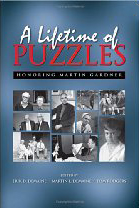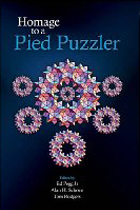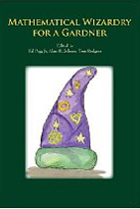'A lifetime of puzzles', 'Homage to a pied puzzler' and 'Mathematical wizardry for a Gardner'
There has been a recent spate of books in honour of Martin Gardner, who has spent over half of his 95 years entertaining us with his recreational mathematics. Matt Parker reviews three of the latest.
 |
 |
 |
A lifetime of puzzlesBy D. Demain, Martin L. Demain and Tom RodgersHomage to a pied puzzlerBy Ed Pegg, Alan H. Schoen, and Tom RodgersMathematical wizardry for a GardnerBy Ed Pegg, Alan H. Schoen, and Tom Rodgers |
Martin Gardner is widely regarded as having started and popularised the area of modern recreational mathematics. Born in 1914, he began his career as an amateur magician, publishing his first magic article in 1930. His strong interest in mathematics lead him to submit an article about flexagons to Scientific American in 1956, starting the Mathematical Games column that he contributed regularly for the next 25 years. During this time he also became a highly influential magician, spending a lifetime turning magicians into mathematicians and mathematicians into magicians.
Gardner's followers from both the mathematics and magic communities get together biennially at what are called the Gatherings for Gardner. Started in 1993, the eighth Gathering for Gardner was in 2008, with the tenth being planned for 2010. At these gatherings ideas from mathematics, puzzles and magic are discussed, following in the vein of the topics and areas first presented by Martin Gardner. The initial 1993 meeting was the idea of Tom Rodgers who is still involved with the Gatherings and is an editor on all three books being reviewed here.
All three books follow the spirit of the Gatherings in that they are collections of articles written by people who were inspired by Gardner. They cover an eclectic range of topics bound together by a hunger for mathematical playfulness — how many circles can you pack into a square, how many colours does it take to colour a torus, and what happens when you play word games on the platonic solids are just some of the questions examined. Some articles in the books are backward looking, examining historic puzzles or mathematical problems, while others develop and explore puzzles first posed by Gardner.
Homage to a pied puzzler and Mathematical wizardry for a Gardner are companion publications by the same editors and are effectively the proceedings from the seventh Gathering. To a novice, reading these books may feel a bit like arriving late at a party where everyone already knows each other. The books assume quite a lot of background knowledge and they're not afraid of being a little self-indulgent. Opening sentences like "Since 1983 I have been researching quasi-periodic patterns based on the Fibonacci Lattice..." may have you wondering if you've missed the beginning of the conversation, while intros like "In this article, I will recount experiences with fellow dancers using giant tangrams as props to create dances..." may make you wonder why you're even in the conversation at all.
A lifetime of puzzles has a slightly different list of editors and is a collection of articles commemorating Martin Gardner's 90th birthday in 2004. While the level of maths in these articles is a bit more advanced than in the other two books, A Lifetime of Puzzles covers the same erratic spectrum, from almost academic papers to anecdotal stories about puzzles.
Now, if you're already familiar with Martin Gardner's work and are feeling annoyed by my slightly derisive tone, then these are the books for you. I'm a huge fan of Martin Gardner — in fact I'm one of the countless mathemagicians who list him as their main inspiration — and I loved trawling through these books for new ideas and intriguing puzzles to try. In my opinion, all three books are worth a read (but if you go for just the one, I'd recommend Homage to a pied puzzler, which I found the most interesting, albeit by the smallest of margins).
If, however, you're not already fluent in Martin Gardner's back-catalogue, I'd suggest you skip the books reviewed here and get your recreational mathematics direct from the father of the genre. The man himself has published over 70 books and there are multiple collections of his Scientific American columns. His 1956 classic Mathematics, magic and mystery, despite being a little archaic in language and tone, is the perfect place to start.But if you have already read Gardner's work and you're eager for more, then any one of these books will get your flexagon-shaped heart racing.
Book details:
A lifetime of puzzles
D. Demain, Martin L. Demain and Tom Rodgers
hardback — 250 pages (2008)
A K Peters
ISBN-10: 1568812450
ISBN-13: 978-1568812458
Homage to a pied puzzler
Ed Pegg, Alan H. Schoen, and Tom Rodgers
hardback — 325 pages (2008)
A K Peters
ISBN-10: 1568813155
ISBN-13: 978-1568813158
Mathematical wizardry for a Gardner
Ed Pegg, Alan H. Schoen, and Tom Rodgers
hardback — 220 pages (2009)
A K Peters
ISBN-10: 156881447X
ISBN-13: 978-1568814476
About the author
Matt Parker is an enthusiastic mathematician whose goal in life is to make more people excited about mathematics. He studied mathematics and physics in Australia before training to be a teacher and working in both Australia and the UK. Matt now writes and speaks about engaging mathematics and his favourite number is currently 28.